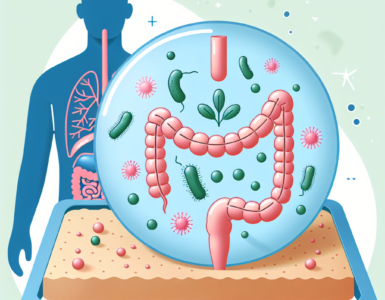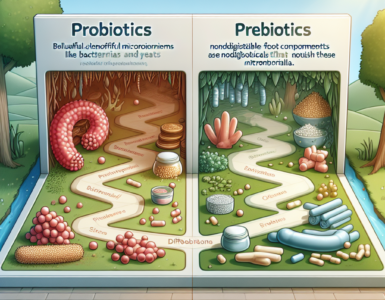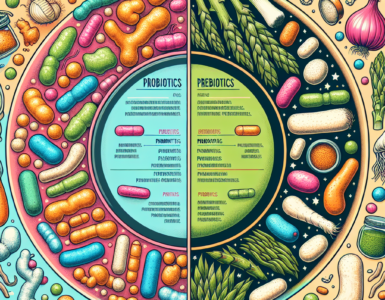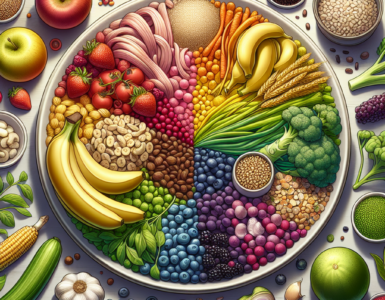Introduction to Nutritional Density
What Is Nutritional Density?
Nutritional density refers to the concentration of essential nutrients in a given volume of food. Nutrient-dense foods provide substantial amounts of vitamins, minerals, complex carbohydrates, lean protein, and healthy fats with relatively few calories. These foods are rich in nutrients compared to their calorie content, making them a vital component of healthy meal planning.
Importance of Nutrient-Dense Foods
The importance of integrating nutrient-dense foods into one’s diet cannot be overstated. They are the building blocks of a healthy diet, supporting the body’s growth, repair, and overall well-being. Consuming these foods can lead to improved health outcomes, including a reduced risk of chronic diseases such as obesity, diabetes, and heart disease. They also play a crucial role in managing weight, as they can create a sense of fullness and satisfaction without excess calorie intake.
For health-conscious individuals, incorporating nutrient-dense foods into their diet is essential for meeting their body’s nutritional requirements. By prioritizing these foods, one can ensure that every meal contributes positively to their health goals, whether that be weight loss, muscle gain, or disease prevention.
| Nutrient-Dense Foods | Nutrients Provided |
|---|---|
| Leafy Greens (e.g., spinach, kale) | Vitamins A, C, K, Iron, Calcium |
| Berries (e.g., blueberries, strawberries) | Antioxidants, Vitamin C, Fiber |
| Legumes (e.g., lentils, chickpeas) | Protein, Fiber, Iron, Folate |
| Nuts and Seeds (e.g., almonds, chia seeds) | Healthy Fats, Protein, Fiber |
| Whole Grains (e.g., quinoa, brown rice) | Complex Carbohydrates, B Vitamins, Fiber |
By choosing foods with high nutritional density, individuals can enhance their diet’s quality and take a proactive step towards maintaining their health. It also sets an excellent example for families looking to establish nutritious eating habits. For dietitians and nutritionists, emphasizing the value of nutrient-dense foods can be a core tenet when advising clients on healthy meal planning.
Key Components of a Nutrient-Dense Meal
Creating a nutrient-dense meal is a cornerstone of healthy meal planning. Understanding the key components that make up such a meal is vital for individuals looking to nourish their bodies effectively.
Macronutrients: Balance and Sources
Macronutrients, including carbohydrates, proteins, and fats, form the basis of any diet and are required in significant amounts for energy, growth, and bodily functions. A balanced meal should include an appropriate ratio of these macronutrients, tailored to individual dietary needs. Here’s a breakdown of the macronutrients and their primary food sources:
| Macronutrient | Function | Food Sources |
|---|---|---|
| Carbohydrates | Energy source | Whole grains, fruits, vegetables |
| Protein | Growth and repair | Lean meats, legumes, dairy, tofu |
| Fats | Energy storage, nutrient absorption | Nuts, seeds, avocados, oils |
Micronutrients: Vitamins and Minerals
While macronutrients are required in larger quantities, micronutrients, which include vitamins and minerals, are needed in smaller amounts, yet they are just as crucial for health. These nutrients aid in various bodily functions such as bone health, immune response, and blood clotting. A nutrient-dense meal should provide a plethora of these micronutrients, which can be found in a diverse range of foods.
| Vitamin/Mineral | Function | Food Sources |
|---|---|---|
| Vitamin A | Vision, immune system | Carrots, sweet potatoes, spinach |
| Vitamin C | Antioxidant, skin health | Oranges, strawberries, bell peppers |
| Calcium | Bone health | Dairy, fortified plant milk, leafy greens |
| Iron | Blood health | Red meats, beans, fortified cereals |
Fiber: The Unsung Hero
Fiber is often overlooked in discussions about nutrient density, yet it plays a significant role in maintaining digestive health, moderating blood sugar levels, and contributing to satiety. A meal rich in fiber is essential for long-term health and can be easily achieved by incorporating a variety of plant-based foods.
| Fiber Type | Function | Food Sources |
|---|---|---|
| Soluble Fiber | Lowers cholesterol, regulates blood sugar | Oats, apples, beans |
| Insoluble Fiber | Aids in digestion | Whole grains, nuts, vegetables |
In healthy meal planning, it’s important to not only focus on the quantity of the food but also the quality. By ensuring a balance of macronutrients, a variety of micronutrients, and an adequate intake of fiber, one can craft meals that are not only delicious but also serve the body’s nutritional needs.
The Role of Hydration in Meal Planning
Hydration plays a pivotal role in healthy meal planning, often overlooked amidst the focus on macronutrients and micronutrients. Water serves multiple essential functions that are key to maintaining health and optimizing the body’s use of the foods we ingest.
Water as an Essential Nutrient
Water is often coined as life’s most essential nutrient. It is involved in every bodily function, from acting as a building block of cells to being a key player in biochemical reactions. Daily water intake is crucial for maintaining balance and is as important as the quality of the food consumed.
The human body is composed of approximately 60% water, and regular replenishment is necessary due to constant loss through breath, perspiration, urine, and bowel movements. The recommended daily water intake varies by individual, influenced by factors such as age, gender, weight, activity level, and climate.
| Factors | Recommended Daily Water Intake |
|---|---|
| Gender (Female) | 2.7 liters |
| Gender (Male) | 3.7 liters |
| Activity Level (Increased) | Additional 1 – 1.5 liters |
| Hot Climate | Additional 0.5 – 1 liter |
These values serve as general guidelines and should be adjusted to align with individual needs and circumstances.
Effects of Hydration on Nutrient Absorption
Water does more than quench thirst—it facilitates the transport of nutrients to cells, aids in digestion, and helps dissolve vitamins, minerals, and other nutrients from food. Proper hydration allows for optimal absorption and utilization of these nutrients within the body.
The process of nutrient absorption begins in the stomach and continues into the intestines, where water-soluble vitamins (such as B vitamins and vitamin C) are absorbed. Additionally, water is necessary for the proper digestion of soluble fiber, which can help control blood sugar levels and reduce cholesterol.
Dehydration, even in mild cases, can impair physical performance, cognitive function, and digestion. It may lead to reduced nutrient absorption and decreased effectiveness of various bodily systems, ultimately impacting overall health.
Incorporating adequate hydration into meal planning is not only about the amount of water consumed but also about the timing. Drinking water before or after meals rather than during can aid in digestion and help the body more effectively process the nutrients from the food.
By understanding the critical role of water as a nutrient and its effect on the absorption of other nutrients, individuals can better plan their meals and hydration patterns to support their health and nutritional goals. Hydration should be considered as integral a part of healthy meal planning as the selection of nutrient-dense foods.
Healthy Meal Planning Strategies
Formulating a meal plan that aligns with principles of optimal nutrition is a cornerstone of maintaining a healthy lifestyle. Here we explore strategies to create meals that fulfil dietary needs, balance the plate nutritionally, and optimize meal timing.
Assessing Dietary Needs
Before diving into meal planning, one must assess their individual dietary needs. These needs can be influenced by factors such as age, gender, activity level, and health goals. Consulting a healthcare professional or a nutritionist can provide personalized guidance.
To start, understanding the recommended daily intake of calories and nutrients is essential. This can be determined by calculating the Basal Metabolic Rate (BMR) and adjusting for activity level to get an estimate of daily caloric needs.
| Factor | Estimated Calories Needed (per day) |
|---|---|
| Sedentary woman | 1,800 – 2,000 |
| Active woman | 2,000 – 2,400 |
| Sedentary man | 2,200 – 2,400 |
| Active man | 2,400 – 3,000 |
After caloric needs are established, the focus shifts to the balance of macronutrients – carbohydrates, proteins, and fats – which should be tailored to support one’s health objectives.
Building a Balanced Plate
A balanced plate is visually divided into sections to help ensure a variety of nutrient-dense foods are consumed at each meal. The following guidelines can serve as a general template:
- Half the plate filled with vegetables and fruits – emphasizing a variety of colors to maximize the intake of different nutrients.
- One quarter of the plate containing lean proteins – such as poultry, fish, beans, or tofu.
- One quarter of the plate made up of whole grains – like brown rice, quinoa, or whole-wheat bread.
- A side of dairy or dairy alternative – to provide a source of calcium and vitamin D.
The balance of these components ensures a harmonious blend of macronutrients and micronutrients, catering to the body’s comprehensive nutritional needs.
Timing Your Meals for Optimal Nutrition
The timing of meals can have a profound impact on energy levels, metabolism, and the body’s ability to absorb and utilize nutrients effectively. Here are some timing guidelines to consider:
- Breakfast: Kick-starts metabolism and refuels the body after overnight fasting. Aim to eat within 90 minutes of waking up.
- Lunch: Sustain energy levels by eating 3 to 5 hours after breakfast.
- Dinner: Consume the last large meal of the day 2 to 3 hours before bedtime to allow for proper digestion.
One may also incorporate small, nutrient-dense snacks between meals to maintain blood sugar levels and curb hunger.
By applying these strategies to healthy meal planning, individuals can craft a diet that supports their health and well-being, recognizing that each person’s needs may vary and adjustments are a normal part of the process.
Incorporating Variety into Your Diet
Maintaining a diverse diet is a cornerstone of healthy meal planning. It involves integrating a wide range of foods to ensure a comprehensive intake of nutrients. This diversity is not only beneficial for the body but also makes meals more enjoyable and culturally enriching.
Benefits of a Diverse Diet
A varied diet supports health by providing a broad spectrum of nutrients that the body requires. It can prevent nutritional deficiencies and reduce the risk of chronic diseases. Additionally, it supports the gut microbiome, as different foods promote the growth of various beneficial bacteria. Diversity in the diet can also make it easier to maintain healthy eating habits, as it prevents boredom with meals.
| Benefits | Description |
|---|---|
| Nutritional Completeness | Ensures all necessary nutrients are consumed. |
| Disease Prevention | Lowers the likelihood of chronic health conditions. |
| Gut Health | Encourages a healthy and diverse gut microbiota. |
| Diet Sustainability | Increases the enjoyment and sustainability of eating habits. |
Exploring Different Food Groups
Incorporating a variety of food groups is critical for obtaining all the macronutrients and micronutrients needed for optimal health. Each food group offers distinct benefits:
- Fruits and Vegetables: Rich in vitamins, minerals, and fiber.
- Grains: A good source of energy-providing carbohydrates and B vitamins.
- Proteins: Essential for muscle repair and growth, immune function, and hormone production.
- Dairy or Alternatives: Provides calcium and vitamin D for bone health.
- Fats and Oils: Necessary for brain health and absorption of fat-soluble vitamins (A, D, E, K).
By including items from each food group in daily meals, individuals can ensure they are getting a balanced intake of nutrients.
Seasonal and Regional Considerations
Eating according to the seasons and local availability not only supports local economies but also ensures that individuals are consuming foods at their nutritional peak. Seasonal produce is often fresher, tastier, and more nutrient-dense than foods shipped from far away. Additionally, regional foods can introduce individuals to a variety of flavors and cooking methods, further diversifying their diet.
| Season | Typical Foods |
|---|---|
| Spring | Leafy greens, berries, asparagus |
| Summer | Stone fruits, tomatoes, cucumbers |
| Autumn | Root vegetables, apples, squash |
| Winter | Citrus fruits, hardy greens, nuts |
Healthy meal planning that incorporates a wide range of foods can significantly enhance the nutritional value of the diet. By embracing the diversity of available foods, individuals can enjoy the numerous health benefits that come with a varied and nutrient-dense diet.
Overcoming Obstacles in Healthy Meal Planning
Healthy meal planning can be a challenge, especially when faced with dietary restrictions, budget constraints, and busy lifestyles. However, with the right strategies, individuals can navigate these hurdles effectively, ensuring that they maintain a nutrient-dense diet that supports their health and well-being.
Dealing with Dietary Restrictions
Dietary restrictions, whether due to allergies, intolerances, or personal choices, can make meal planning seem more complex. The key is to focus on the variety of foods that can be consumed rather than those that are off-limits.
For those with gluten intolerance, for example, grains like quinoa, rice, and certified gluten-free oats can be excellent alternatives. Those following a vegetarian or vegan diet can obtain their protein from legumes, tofu, tempeh, and a variety of nuts and seeds.
| Dietary Restriction | Food Alternatives |
|---|---|
| Gluten-Free | Quinoa, Rice, Gluten-Free Oats |
| Lactose-Free | Almond Milk, Coconut Yogurt, Lactose-Free Cheese |
| Vegetarian/Vegan | Legumes, Tofu, Nuts |
By focusing on what can be included, individuals can create a balanced meal plan that respects their dietary restrictions while still providing the necessary nutrients.
Budget-Friendly Nutrition
Eating nutrient-dense foods doesn’t have to break the bank. There are numerous ways to incorporate healthy foods into your diet while being mindful of your budget.
Purchasing produce in season, opting for frozen fruits and vegetables, and buying in bulk are all strategies that can help save money. Additionally, focusing on whole foods rather than processed items often results in both health and financial benefits.
To make the most of your budget, planning meals around affordable protein sources like beans, lentils, and eggs can also be cost-effective. The table below provides examples of budget-friendly, nutrient-dense foods.
| Nutrient-Dense Food | Estimated Cost |
|---|---|
| Lentils (1 lb) | $1.50 |
| Brown Rice (1 lb) | $2.00 |
| Frozen Spinach (10 oz) | $1.00 |
By seeking out deals and discounts, individuals can enjoy a variety of healthy foods without overspending.
Time-Saving Tips for Busy Lifestyles
Time constraints are a common barrier to healthy meal planning, but there are ways to streamline the process. Meal prepping in advance, using a slow cooker for batch cooking, and preparing simple, one-pan dishes can help save time.
Creating a weekly meal plan can also reduce the time spent deciding what to cook each day. By setting aside a few hours during the weekend to prepare and store meals, individuals can ensure they have healthy options readily available throughout the week.
| Meal Prep Strategy | Time Saved |
|---|---|
| Batch Cooking | 3-4 hours per week |
| One-Pan Dishes | 30 minutes per meal |
| Weekly Meal Planning | 2-3 hours per week |
With these strategies, even those with the busiest schedules can enjoy nutritious, home-cooked meals without spending excessive time in the kitchen.
Intelligent Grocery Shopping
Smart grocery shopping is a cornerstone of healthy meal planning. It involves selecting foods that contribute to a nutrient-dense diet, understanding how to read nutrition labels for informed choices, and organizing shopping trips to align with your nutritional goals.
Prioritizing Whole Foods
Whole foods should be at the forefront of any nutrient-rich diet. These foods are in or close to their natural state and have not been heavily processed. They are typically abundant in essential nutrients and devoid of added sugars, fats, and preservatives that can negate their health benefits.
When shopping, focus on these categories:
- Fresh fruits and vegetables
- Whole grains
- Lean proteins
- Legumes and beans
- Nuts and seeds
Reading and Understanding Nutrition Labels
Nutrition labels are your guide to making healthier choices. They provide valuable information on the calorie content, macronutrient breakdown, and vitamin and mineral content of foods. However, they can be confusing. Below are the key components to focus on:
- Serving Size: Indicates the typical amount consumed and all the nutritional information on the label is based on this amount.
- Calories: Provides a measure of how much energy you get from a serving.
- Nutrients: Pay close attention to dietary fiber, sugars, vitamins, and minerals.
- % Daily Value (DV): Shows how much a nutrient in a serving of food contributes to a daily diet.
| Nutrient | Recommended DV% |
|---|---|
| Total Fat | Less than 100% |
| Sodium | Less than 100% |
| Dietary Fiber | As high as possible |
| Sugars | As low as possible |
| Vitamin D, Calcium, Iron, and Potassium | As high as possible |
Planning Ahead with Meal Lists and Schedules
Creating a meal plan and a corresponding shopping list is a practical way to ensure you purchase all the necessary ingredients for your nutrient-dense meals. It also helps to avoid impulse buys that may not align with your health goals.
Consider these steps for effective planning:
- Identify Meals and Snacks: Determine what you’ll eat throughout the week.
- Create a Shopping List: List all ingredients needed for your planned meals.
- Schedule Your Shopping: Designate a regular day and time to shop, reducing the need for multiple trips.
By implementing these intelligent grocery shopping strategies, you will be better equipped to maintain a diet rich in nutrient-dense foods, which is a key component of healthy meal planning. This approach not only supports your health goals but can also lead to time and cost savings.
The Impact of Cooking Methods on Nutrition
The methods by which food is prepared and cooked can significantly affect its nutritional content. Understanding how different cooking techniques impact the preservation of nutrients is essential for healthy meal planning.
Preserving Nutrients While Cooking
When cooking, certain vitamins and minerals can be lost. Water-soluble vitamins, such as vitamin C and B vitamins, are particularly susceptible to breakdown during cooking processes involving water or high heat. To preserve these essential nutrients, certain strategies can be implemented:
- Utilize cooking methods that require less water, such as steaming or sautéing, to reduce the leaching of water-soluble vitamins.
- Shorten cooking times where possible, as prolonged exposure to heat can degrade heat-sensitive nutrients.
- Cook vegetables until they are just tender to minimize nutrient loss while still ensuring they are safe and enjoyable to eat.
- Use the cooking liquid, where vitamins and minerals may have leached into, as a base for soups and sauces to retain the nutrients.
| Cooking Method | Nutrient Retention Strategy |
|---|---|
| Boiling | Use minimal water and repurpose cooking liquid |
| Steaming | Steam until just tender to preserve water-soluble vitamins |
| Sautéing | Use a quick, high-heat method to retain more nutrients |
| Microwaving | Cook for shorter periods and with less water to prevent nutrient loss |
Healthy Cooking Techniques
Choosing the right cooking methods can enhance the nutritional quality of meals while also providing variety in flavor and texture. Some techniques that support healthy meal planning include:
- Steaming: This method preserves the maximum amount of nutrients and is ideal for vegetables, fish, and poultry.
- Grilling: Grilling over an open flame can impart a smoky flavor and minimize the need for added fats.
- Baking: Baking can be a healthful choice, especially when minimizing the use of oils and butters.
- Sautéing: Using a small amount of healthy oil, such as olive oil, can add flavor and aid in nutrient absorption without overcooking ingredients.
- Blanching: A quick method for vegetables that locks in color and nutrients, followed by an immediate cold water bath to cease the cooking process.
Incorporating these techniques into your healthy meal planning can ensure that the nutritional value of your foods is as high as possible. By being mindful of how food is prepared, individuals can maximize their intake of essential nutrients, contributing to overall health and wellness.
Monitoring and Adjusting Your Meal Plan
Effective healthy meal planning is not a one-time event but rather an ongoing process that requires regular monitoring and adjustments to align with one’s nutritional goals and bodily responses.
Tracking Nutritional Intake
Keeping a detailed record of food and beverage intake is a foundational step in understanding whether one’s diet meets their nutritional needs. By tracking daily consumption, individuals can ensure they are incorporating a balance of macronutrients and micronutrients essential for optimal health.
One method to facilitate this tracking process is to use a food diary or a digital tracking app where individuals can log their meals and snacks. This record can then be reviewed to identify any nutritional gaps or areas of excess.
| Meal | Macronutrients (g) | Micronutrients | Calories |
|---|---|---|---|
| Breakfast | Carbs: 30, Protein: 20, Fat: 10 | Vitamin C, Calcium | 350 |
| Lunch | Carbs: 45, Protein: 30, Fat: 15 | Iron, Vitamin A | 500 |
| Dinner | Carbs: 50, Protein: 25, Fat: 20 | Potassium, Vitamin E | 600 |
Recognizing and Responding to Body Signals
Listening to one’s body is critical when it comes to healthy meal planning. Body signals such as energy levels, hunger, fullness, mood changes, and physical performance provide valuable feedback about the adequacy and suitability of one’s diet.
For example, persistent fatigue might indicate insufficient caloric intake or a lack of certain vitamins and minerals. Conversely, consistent overfullness might suggest an overconsumption of calories or a particular macronutrient.
Responding to these signals may involve adjusting meal portion sizes, meal timing, or the balance of food groups to better cater to the body’s needs.
When to Revise Your Meal Plan
A meal plan should be a dynamic guide that evolves with changing health goals, lifestyle modifications, and nutritional knowledge. It is advisable to revise one’s meal plan under the following circumstances:
- Changes in health status (e.g., diagnosis of a health condition)
- Adjustments in physical activity level (e.g., starting a new exercise regimen)
- Shifts in life stages (e.g., pregnancy, aging)
- Lack of progress towards health goals (e.g., weight management, muscle building)
- New scientific guidelines or recommendations for nutrition
Regular check-ins, perhaps monthly or quarterly, with a healthcare provider or a nutritionist can provide expert insight into whether the current meal plan is effective or needs refinement. These professionals can help interpret body signals and tracking data to make informed decisions about dietary adjustments.
Healthy meal planning is not a static process, and being open to making changes is vital for long-term nutritional success and well-being. By tracking intake, listening to the body, and being willing to adapt, individuals can maintain a diet that supports their health and lifestyle goals.
Important Disclaimer: Understanding Nutritional Density and Your Health
Please note that while we strive to provide accurate and up-to-date information about nutritional density and its importance in a balanced diet, the content presented in this article is for educational and informational purposes only. It should not be construed as medical advice or a substitute for professional dietary counseling or medical consultation. Nutritional needs can vary significantly from person to person, depending on various factors including age, gender, health status, and physical activity levels.
Before making any significant changes to your diet or if you have specific health concerns, it is important to consult with a qualified healthcare provider or a registered dietitian. They can offer personalized advice and guidance based on your individual health profile and nutritional needs.
Furthermore, while we discuss the benefits of incorporating nutrient-dense foods into your daily meals, we recognize that dietary preferences and restrictions can vary widely. We encourage readers to adapt the suggestions and recipes to fit their personal tastes, dietary restrictions, and nutritional goals.
Lastly, the views and opinions expressed in this article are based on current nutritional research and knowledge. However, nutritional science is continually evolving, and new research may lead to adjustments in our understanding of what constitutes a healthy diet. As such, we recommend staying informed through reputable sources and ongoing education.











